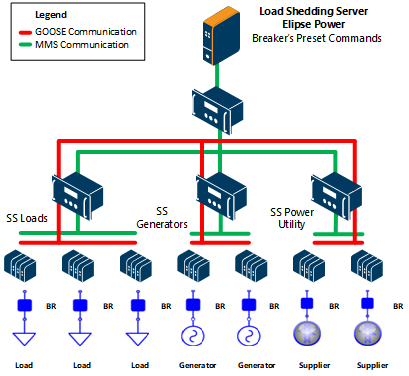Elipse Power's Load Shedding Module works with the concept of pre-evaluating situations that may lead to instability of an electrical system and with the selection of sets of loads that must be shed if any of these events occur. To do so, this Module is responsible for constantly simulating, in a cycle of a few seconds, which loads must be shut down when an instability situation occurs. This way, the Module allows the protection system to stay informed about which breakers must operate before an instability event occurs, avoiding that the processing time to identify the set of loads be added to the total time between detecting an event and effectively shutting down these loads.
The set of selected loads for shedding is retrieved from load priorities, from active power values informed by the supervisory system, from operation availability of IEDs, and from the system's topological status (a network topological model created based on the status of Switches and Breakers and the connectivity between these devices). Once identified a set of Breakers that must operate for each event, the protection system is preset using the communication system used by the automation (system without time commitment in milliseconds). Thus, when the instability event occurs, only the protection system is responsible for operating the shutdown of preset Breakers (time commitment in milliseconds).
The next figure presents an example application of a Load Shedding Module integrated to a network of IEC 61850 standard IEDs. Users can identify that presetting Breakers and reading the electrical status (Breaker's status variables and power measurements) are performed using a protocol without a strict time commitment (such as the MMS protocol), while the communication needed to detect an instability event and operate a shedding operation is performed by a protocol with time commitment (such as a GOOSE message of the IEC 61850 protocol).

Example of an application with IEC 61850 standard IEDs
In the previous example, if a shutdown operation of an interconnection Breaker of a power utility occurs, the IED responsible for this Breaker sends a GOOSE message to all other IEDs (broadcast), indicating a disconnection from the supplier system. At that time, only IEDs preset by Elipse Power to operate when a loss of connection occurs must operate. As the preset calculation was previously performed by Elipse Power, the task of IEDs of loads is only to handle the GOOSE message and check if its Breaker must be shut down or not. This way, time involved remains as tens of milliseconds and the whole detection and shedding process is performed only among IEDs using a high performance protocol (GOOSE).